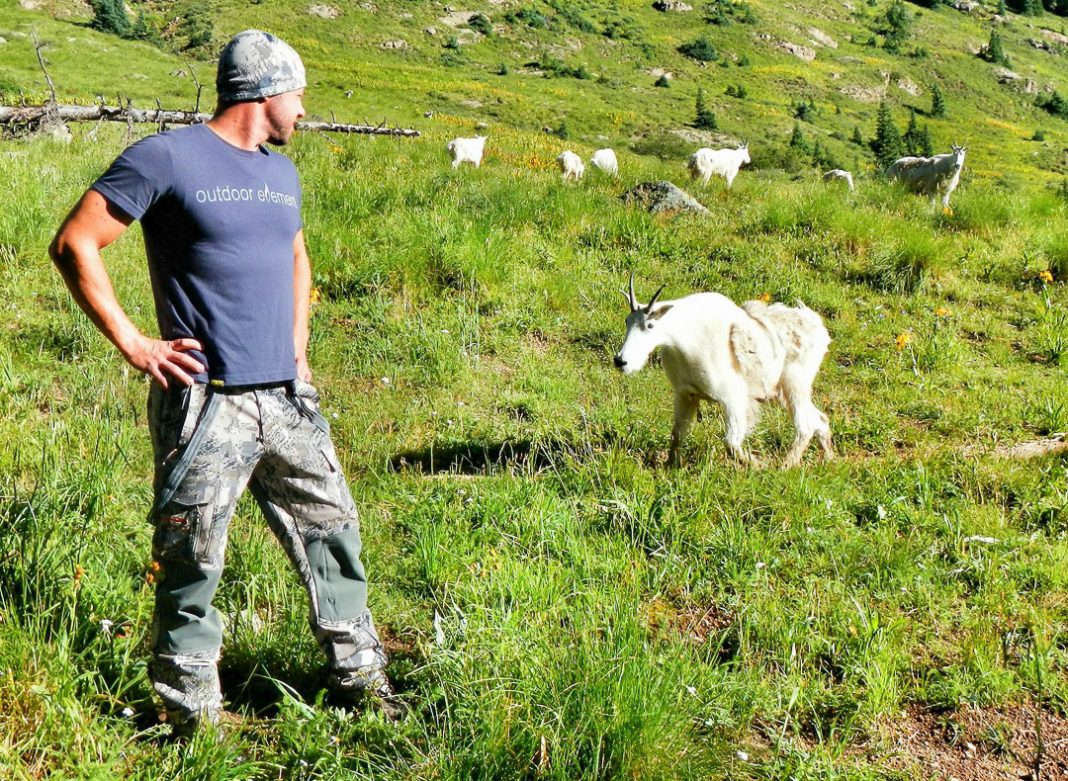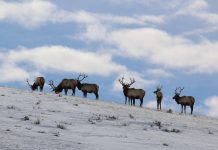Last year WDFW approved a goat management plan that included translocating the animals to the northern Cascade Mountains. The large population of goats in the Olympic National park and National Forest had become a nuisance because of their attraction to people. They naturally crave salt which is not always readily available from natural sources. Humans become the best source through their sweat and urine. People hand feed the goats and urinate on the trails conditioning the animals to stay close to humans.
The translocation program will continue at the beginning of July.
The Washington Department of Fish and Wildlife released the following:
Starting July 8, a coalition of state and federal agencies, with support from local tribes, will begin the second two-week round of translocating mountain goats from Olympic National Park and Olympic National Forest to the northern Cascade Mountains to meet wildlife management goals in all three areas.
This effort is a partnership between the National Park Service (NPS), the Washington Department of Fish & Wildlife (WDFW), and the USDA Forest Service (USFS) to re-establish and assist in connecting depleted populations of mountain goats in the Washington Cascades while also removing non-native goats from the Olympic Mountains. Mountain goats were introduced to the Olympics in the 1920s.
“A project of this magnitude would be impossible without our partner agencies and the expertise and cooperation of hundreds of people,” said Olympic National Park Wildlife Branch Chief Dr. Patti Happe. “The interagency collaboration and the support from everyone involved is extraordinary.”
Area tribes lending support to the translocation plan in the Cascades include the Lummi, Muckleshoot, Sauk-Suiattle, Stillaguamish, Suquamish, Swinomish, Tulalip, and Upper Skagit tribes. Volunteers from the Point No Point Treaty Council, Quileute Tribe, Quinault Indian Nation, Skokomish Indian Tribe, and Port Gamble S’Klallam Tribe will also be assisting at the staging areas in the Olympics.
In May 2018, the NPS released the final Mountain Goat Management Plan which outlined the effort to remove mountain goats on the Olympic Peninsula. The population of mountain goats at that time was estimated at 725. Both the plan and the associated environmental impact statement were finalized after an extensive public review process which began in 2014.
The first two-week capture period in September 2018 removed 115 mountain goats from the population in the park. An additional two-week period is planned for this year beginning August 19 through 30.
“Mountain goat relocation will allow these animals to reoccupy historical range areas in the Cascades and increase population viability,” said Jesse Plumage, USFS Wildlife Biologist.
While some mountain goat populations in the north Cascades have recovered since the 1990s, the species is still absent from many areas of its historic range.
Aerial capture operations will be conducted through a contract with Leading Edge Aviation, a private company that specializes in the capture and transport of wild animals. The helicopter crew will use immobilizing darts and net guns to capture mountain goats and transport them in specially made slings to the staging areas.
While capture operations will be conducted throughout the park and national forest for both two-week periods, a few locations that are known to have a high number of mountain goats will be areas of focus for the capture crew. On the first two days of the capture period, the emphasis will be on the Klahhane Ridge and Appleton Pass areas. The Seven Lakes Basin area and the Lake of the Angels area in the southeast have a high number of mountain goats that the capture crew will be working to remove. In August, Mount Ellinor in Olympic National Forest will be an area of focus.
This year there will be two staging areas for each two-week period. For July and August, one staging area will be located on Hurricane Hill Road beyond the Hurricane Ridge Visitor Center in Olympic National Park. The other staging area will be located in Olympic National Forest in the Hamma Hamma area in July and switch to the Mt. Ellinor area in August. The staging areas will be closed to public access.
The animals will be cared for by veterinarians before WDFW wildlife managers transport them to staging areas in the north Cascades for release. To maximize success, goats will be airlifted in their crates by helicopter directly to alpine habitats that have been selected for appropriate characteristics.
WDFW plans to release the mountain goats at six sites in the Cascades in July. Three of the release sites will be staged from the Mt. Baker-Snoqualmie National Forest (MBS). These release sites include the Chikamin area on the Okanogan-Wenatchee National Forest, Preacher Mountain on the MBS, and Hardscrabble Ridge on an inholding owned by Forterra. Two release areas are near mountain peaks south of the town of Darrington on the Darrington District of the MBS. The other is near Mt. Index on the Skykomish Ranger District of the MBS.
Mountain goats follow and approach hikers because they are attracted to the salt from their sweat, urine, and food. That behavior is less likely in the north Cascades where visitors are more widely distributed than those at Olympic National Park, said Dr. Rich Harris, a WDFW wildlife manager who specializes in mountain goats.
“In addition, the north Cascades has natural salt licks, while the Olympic Peninsula has virtually none,” Harris said. “We’d expect salt hunger to be lower in goats that have natural sources available to them.”
Trail Impacts and Road Closures
Hurricane Hill Road, beyond the Hurricane Ridge Visitor Center parking lot, will be closed to all access during both operational periods. Hurricane Hill Road will remain open up to Picnic Area A on July 5 and July 6 during the setup of the staging area. The road will then be closed completely beyond the Hurricane Ridge Visitor Center from July 7 through 20 for mobilization, capture operations, and demobilization. This closure includes the Hurricane Hill Trail, Little River Trail, and Wolf Creek Trail. The Klahhane Ridge area will close temporarily on July 8 and 9 for visitor and employee safety during capture operations. The area of Seven Lakes Basin/High Divide/ Heart Lake/ Hoh Lake/ to Cat Basin will be closed to hiking and overnight camping July 7 through 11. The area of Lake of the Angels, accessed from Putvin Trail #813 off Forest Road 25 in Olympic National Forest, will be closed at mile 3 at the park boundary from July 9 through July 18.
For the July release operations on the Mt. Baker-Snoqualmie National Forest, land adjacent to the roadway at the junctions of Forest Service Roads 49 and 4920 will be closed from July 9 through July 21, 2019.
For the August capture operations, the Mount Ellinor trails system and Forest Road 2419 to Mount Ellinor, as well as Forest Road 2464 leading to Forest Road 2419, will be closed to the public starting the evening of August 18 until the morning of August 30.
What do you think of the plan to redistribute the goats?















